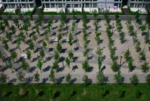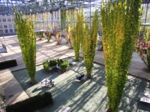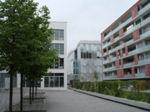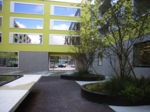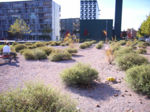Parks in Neu Oerlikon: Difference between revisions
| Line 41: | Line 41: | ||
=== Cultural/social/political context=== | === Cultural/social/political context=== | ||
* | * | ||
The inhabitants of Neu Oerlikon lived already in former times in the north from Zurich. Most moved from an old building into the current dwellings in new housing development. That means that the inhabitants are in the broadest sense social advancements. At the beginning the apartments were low priced to very low price, which partly changed now. Slowly a good mixing develops of offers: | |||
*Simple rented apartments | |||
*cooperative domicile | |||
*offers for the elevated middle class | |||
*a senior residence | |||
*apartments for students. | |||
The new quarter is no typical suburb because it is inhabited of different social classes. | |||
=== History === | === History === | ||
Revision as of 11:05, 10 January 2009
Parks in Neu Oerlikon, Zurich, Switzerland: MFO Park, Wahlen Park, Oerliker Park
Rationale: Why is this case study interesting?
In the north of Zurich a new quarter developed: Neu (new-) Oerlikon. The planned urban development proceeded not as the foreseen 10 years. It has been allready realized in 5 years. That quarter is considered as a pioneer project. Large-scaled architectural competition was arranged for fastidious buildings and internationally considered places, partly already realized. Although the quater is international advertance, its inhabits deplore the missing life, anonymity, too few meeting places, the coldness of architecture and the too perfect parks.
Author's perspective
The projects in Neu Oerlikon have an invaluable value for landscape architecture in Switzerland in addition, particularly for the inhabitants of Zurich. The both authors live even in the agglomeration and have therefore personal purchases to the quarters developed again. Neu Oerlikon is an important topic for the open space designing of the city Zurich. However the inhabitants criticize the clinical atmosphere of the new quarters. For students of landscape architecture in Switzerland the parks of Neu Oerlikon was for a long time the main working on topic. Anywhere otherwise in Switzerland so many parks did not develop close together in the last years in such short time. By the precise and exact work with Neu Oerlikon in the study developed a partly very critical attitude opposite the new parks.
Landscape and/or urban context
Neu Oerlikon is in the north of Zurich and developed on a former industrial area. 12,000 new jobs and domiciles for 5,000 new inhabitants developed. There are three new main parks: Oerliker park, MFO park and Wahlen park. The organization of the parks reminds strongly of the former industrial use. orthogonal and geometrical alignments are coining for these. In the context of the rearrangement of zones of the industial zone in trade and apartment zone, a large pressure developed on the planners . They had to fulfill the edition to sufficient green area to create. Thus three different park types with special uses developed. The Wahlen park had to fulfill still the task of a schoolyard. The Oerliker park had to have the qualities of an accomodation park and besides an urban place character to obtain. The MFO park should have the multi-functionality of an event hall and besides offer free space for employed persons.
Cultural/social/political context
The inhabitants of Neu Oerlikon lived already in former times in the north from Zurich. Most moved from an old building into the current dwellings in new housing development. That means that the inhabitants are in the broadest sense social advancements. At the beginning the apartments were low priced to very low price, which partly changed now. Slowly a good mixing develops of offers:
- Simple rented apartments
- cooperative domicile
- offers for the elevated middle class
- a senior residence
- apartments for students.
The new quarter is no typical suburb because it is inhabited of different social classes.
History
Oerlikon was the seat of the formerly largest weapon factory of Switzerland. At that time the „Oerlikon-Bührle“ could owe the rearmament efforts around 1938 large orders secure itself and supplied both European-wide and until Asia. 1966 to 1969 on the area shooting tests with ammunition uranium-bearing were accomplished. 1999 the firing ranges were broken off and disposed of as special refuse. Today there is a park and a new family-friendly housing development. However it does not exist a danger for human’s health and environment. On this historical significant industrial area in the last 10 years an apartment and a service center were planned, which becomes in these days reality.
Illustration: Table or time line
Spatial analysis of area/project/plan
- What are the main structural features?
- How has it been shaped? Were there any critical decisions?
Illustration: Map/diagram/sketches photos and background notes
Core questions working group open spaces
How does the design of an open space contribute to a run down neighbourhood?
test, test, test
How are open spaces linked to the adjacent areas?
(e.g. neighbourhoods, city centre, river)
How are open spaces used?
(e.g. which groups meet there, which functions does an open space fulfil)
Which elements make an open space successful and attractive?
How can the historical background of an open space be shown to the public?
Core Questions Working Group Public Space and Civic Identity
Who was involved in the participation process?
The town planning of Neu Oerlikon was activated by office for town construction Zürich. It gave an advertisement and it participated several offices, witch are not in particular known. Planning was in several stages on different offices. The parks were an assignment of „Grünstadt Zürich“. The Oerliker Park and Louis Häfliger Park were orders for study The Wahlen Park and MFO Park were competitions.
The Oerliker Park was planned by Zulauf, Hubacher, Haerle.
The MFO Park was planned by Raderschall landscape architect.
The Wahlen Park was planned by Dipol landscape architects.
The Louis Häfliger Park was planned by Stephan Kuhn, Richard Trunninger landscape architect.
Participation of the population did not give it.
How was the participation process implemented (methods applied)?
The participation is limited to the competitions and orders for study
In how far does/did the project respond to people's needs?
The four parks would become the area after, that uncover need of the public free room. The artistic quality of the parks is very high. Because it concerns however some new city quarters, the parks are not bound yet sufficient. The inhabitants perceive the parks clean. The Wahlen park is supposed well and goes on the needs of the inhabitant on. It leigt directly next to a school and should serve in addition to park also as a school sport meadow. The schoolchildren and teenager use the park also in the leisure time. The MFO Park reminds strongly of the original buildings. The steel construction offers shadow and different levels to rest. This park offers further attractions such as Openair movie theater or temporarily art exhibitions or café. The Oerliker park is integrated at worst of all. The ash trees are yet small and contribute no shadow. The idea of the architects that the park users functioned do not change the park gradually. The users do not played with the stones or moved settee.
The lower utilization of the park is to be led back to the new quarters Oerlikon. Neu Oerlikon emerged within 5 years although 15 years were budgeted to the development. In this short time, the quarters were not able to develop yet an own character and becomes therefore very clinical and empty perceived. Stores and boutiques be missing, animate would become that the quarters and would have also a positive effect on the parks. On gives another little time the parks and places be used and appreciated.
Analysis of program/function
- What are the main functional characteristics?
- How have they been expressed or incorporated?
Illustration: Map/diagram/sketches photos and background notes
Analysis of design/planning process
- How was the area/project/plan formulated and implemented?
- Were there any important consultations/collaborations?
Illustration: Map/diagram/sketches photos and background notes
Analysis of use/users
- How is the area/project/plan used and by whom?
- Is the use changing? Are there any issues?
Illustration: Map/diagram/sketches photos and background notes
Future development directions
- How is the area/project/plan evolving?
- Are there any future goals?
Illustration: Map/diagram/sketches photos and background notes
Peer reviews or critique
- Has the area/ project/plan been reviewed by academic or professional reviewers?
- What were their main evaluations?
Pleas add references, quotes...
Points of success and limitations
- What do you see as the main points of success and limitations of the area/project/plan?
Illustration: Summary table
What can be generalized from this case study?
- Are there any important theoretical insights?
Short statement plus background notes
Which research questions does it generate?
Short statement plus background notes
Image Gallery
References
Please add literature, documentations and weblinks
About categories: You can add more categories by copying the tag and filling in your additional categories



